Morning Exercises
Morning Exercises
History of Commencement’s Morning Exercises at Harvard University
Excerpts from Cynthia Wight Rossano’s THESE FESTIVAL RITES, found in Commencement’s official “Order of Exercises” printed program.
For additional information, please see links down below.
History of Commencement
The word ‘Commencement’ conveys the meaning of the Latin Inceptio, a term used in the Middle Ages to describe the ceremony that admitted candidates for the degree of Master of Arts and gave them license to begin teaching. The first ‘Happy Observance of Commencement’ at Harvard College was held in the autumn of 1642, with nine scholars in the graduating class. Throughout the seventeenth century the ceremony was celebrated at the beginning of the academic year; the change of Commencement to the end of the academic year recognized that not all graduates would become teachers, and that at Commencement recipients of degrees would leave the University to begin their professional lives.
Decorations in the Tercentenary Theatre
Tercentenary Theatre, the area between the Memorial Church and Widener Library, was first used in 1936 as an outdoor amphitheatre for the College’s three hundredth anniversary, and today is ablaze with the reds, blues, greens, and golds of the varied flags of the University. Flags of Harvard and Radcliffe decorate the theatre for Commencement, while the three large crimson Harvard Veritas banners, bearing the ancient shield, billow above the long staircase in front of Widener. Also flying overhead are the brilliant colors of the thirteen undergraduate houses: Adams, Cabot, Currier, Dudley, Dunster, Eliot, Kirkland, Leverett, Lowell, Mather, Pforzheimer, Quincy, and Winthrop. Rounding out the heraldic display are the bright standards of the twelve graduate schools.
Academic Procession
The Commencement procession is formed in four divisions. Each meets in a prescribed area where, as President Conant noted, they happily “wander about, greeting friends and disobeying instructions” before starting on the walk into Tercentenary Theatre. As the processors pass by the west front of University Hall they doff their hats to Daniel Chester French’s imaginative statue of John Harvard — “imaginative” since there is no image extant of John Harvard  and French’s statue is sculpted from an undergraduate model; John Harvard wasn’t ‘Founder’ but rather the College’s first benefactor, and the date of the College’s founding is 1636, not 1638. Candidates for advanced degrees from the far-flung graduate and professional schools gather in three divisions in Sever Quadrangle — until 1946 the site of the Commencement Exercises — for their march into the Theatre, having tinged the roads of Cambridge with color as they approached. The graduating class of seniors, the alumni/ae, and the President’s Division emerge from lively confusion to find their places in the Old Yard as the Harvard University Band plays the familiar college songs.
and French’s statue is sculpted from an undergraduate model; John Harvard wasn’t ‘Founder’ but rather the College’s first benefactor, and the date of the College’s founding is 1636, not 1638. Candidates for advanced degrees from the far-flung graduate and professional schools gather in three divisions in Sever Quadrangle — until 1946 the site of the Commencement Exercises — for their march into the Theatre, having tinged the roads of Cambridge with color as they approached. The graduating class of seniors, the alumni/ae, and the President’s Division emerge from lively confusion to find their places in the Old Yard as the Harvard University Band plays the familiar college songs.
The President’s Division consists of several sections, the first led by the sheriffs of Middlesex and Suffolk counties. The president follows immediately behind, wearing a black front-buttoned cassock under a heavy full gown embroidered at collar and cuffs, which is derived from seventeenth century Puritan clerical dress and is the only such presidential regalia worn in this country today.
 The University Marshal oversees the Commencement Exercises, escorts the president and the presidents emeriti, if present, and is followed by the other members of the Corporation, the provost, and members of the Board of Overseers.
The University Marshal oversees the Commencement Exercises, escorts the president and the presidents emeriti, if present, and is followed by the other members of the Corporation, the provost, and members of the Board of Overseers.
Then come the deans and vice presidents, followed by the dignitaries, including ministers from the original Six Towns of the Bay Colony, other invited clergy, officials of the Commonwealth or nation, the Phi Beta Kappa Poet and Orator, former recipients of honorary degrees, and invited guests.
The Faculty section of the President’s Division is made up of faculty deans, professors emeriti, University Professors, professors, associate professors, and assistant professors. This section is immensely colorful because of the rich and varied display of academic gowns and hoods. The color, length, and shape of each academic hood represent a particular institution and the subject in which the degree was awarded. Harvard's practice is unique in that four types of gowns are used: black for both Bachelor of Arts and Master of Arts degree candidates, black for professional advanced degrees such as in Business and in Law, and crimson for the degree of Doctor of Philosophy. Hoods signifying Harvard degrees are black with crimson silk linings, differing only in length for master and doctoral candidates. Embroidered crow's feet on the lapels of their gowns are colored according to the faculties they represent, with white for the Faculty of Arts and Sciences, and the Extension School; dark blue for Doctor of Philosophy; drab or khaki for Business; lilac for Dental Medicine; yellow for Design; scarlet for Divinity; light blue for Education; peacock blue for Government; purple for Law; green for Medicine; salmon pink for Public Health, and orange-gold for Engineering and Applied Sciences. Crow’s feet are double for earned degrees, triple for honorary.
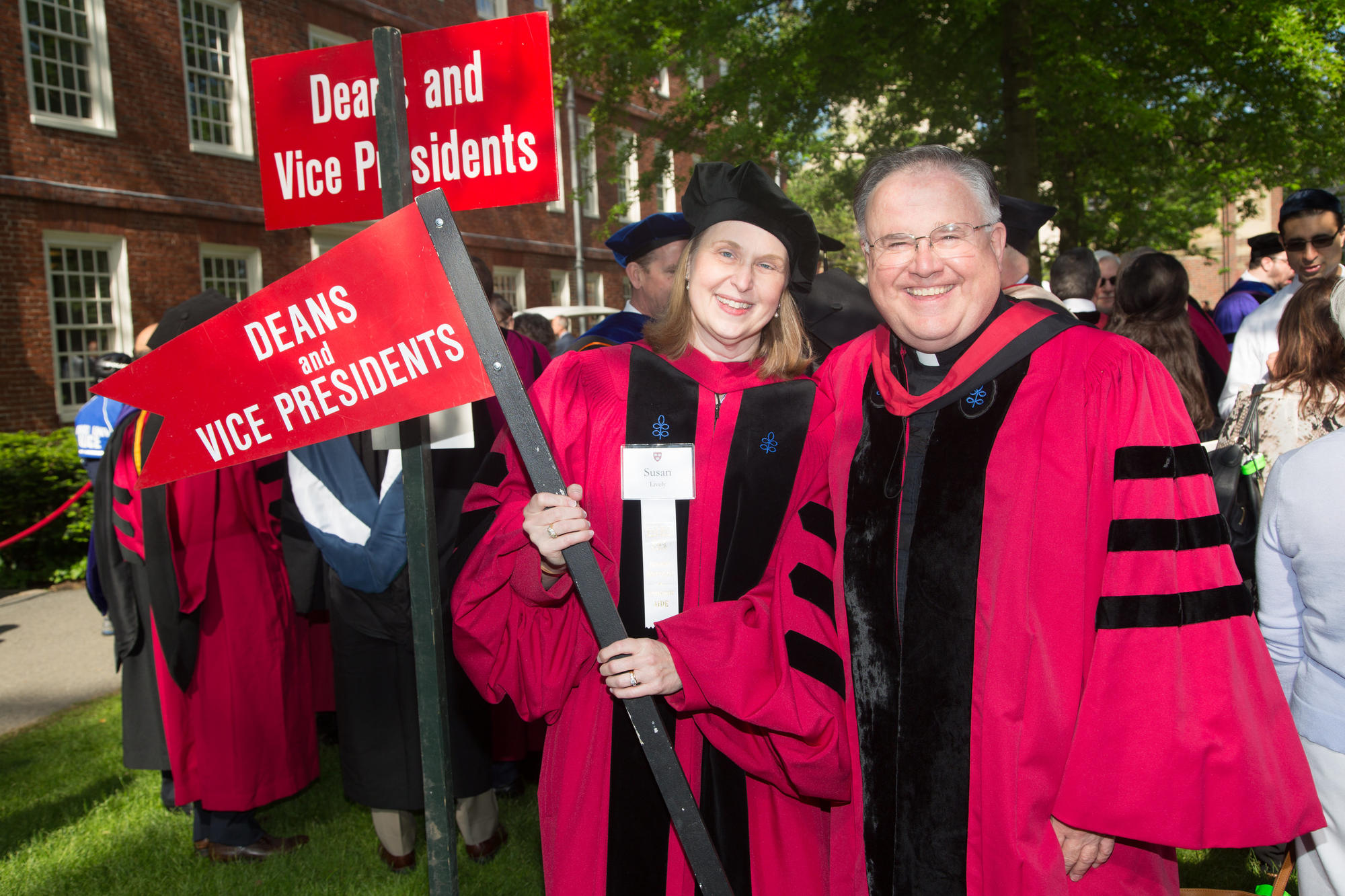 The President’s Division takes its place on the platform built for the occasion on the south porch of the Memorial Church. The president sits in the center in a Jacobean chair used at Harvard Commencements since the time of President Holyoke in the eighteenth century. The treasurer and fellows are seated at either side of him. In the center section of the platform are the honorands with their faculty escorts, the members of the Board of Overseers, the vice presidents of the University, the clergy, the deans of the graduate schools, the faculty deans of the undergraduate houses, and specially invited guests. Looking toward the platform, to the far left are one hundred fifty of the most senior alumni/ae, and to the far right are faculty members.
The President’s Division takes its place on the platform built for the occasion on the south porch of the Memorial Church. The president sits in the center in a Jacobean chair used at Harvard Commencements since the time of President Holyoke in the eighteenth century. The treasurer and fellows are seated at either side of him. In the center section of the platform are the honorands with their faculty escorts, the members of the Board of Overseers, the vice presidents of the University, the clergy, the deans of the graduate schools, the faculty deans of the undergraduate houses, and specially invited guests. Looking toward the platform, to the far left are one hundred fifty of the most senior alumni/ae, and to the far right are faculty members.
When all participants in the academic procession are seated in the Tercentenary Theatre, the University Marshal signals for the ringing of the deep-toned bell of the Memorial Church. To announce the beginning of the Commencement Exercises, on this day the five thousand pound bronze bell is rung by hand.
Meeting Called to Order
The University Marshal addresses the sheriff of Middlesex County, “Mr. Sheriff, pray give us order.” The sheriff, resplendent in silk top hat, rises, moves solemnly to the front of the platform and, striking it three times with his silver-tipped staff, proclaims in a resonant voice, “The meeting will be in order.” The Chaplain of the Day offers a prayer, and the University Marshal proceeds to introduce the three student speakers of Commencement Parts.
Commencement Parts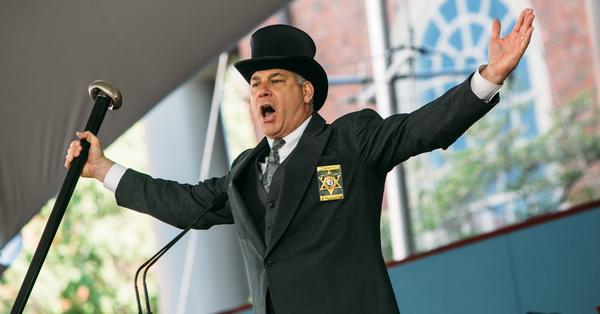
The giving of Commencement Parts began early in Harvard’s history when candidates chosen by a faculty committee for their outstanding achievement spoke ‘Parts’ in Greek, Latin, and Hebrew. This practice continues to the present, with selected students delivering the Parts at the opening of the ceremony. In the first, a College senior delivers a ‘salutatory,’ or address of greeting in Latin. A second senior gives an address in English, and a professional degree candidate then presents the third address, also in English. For all of the Parts, students are chosen in a University-wide competition.

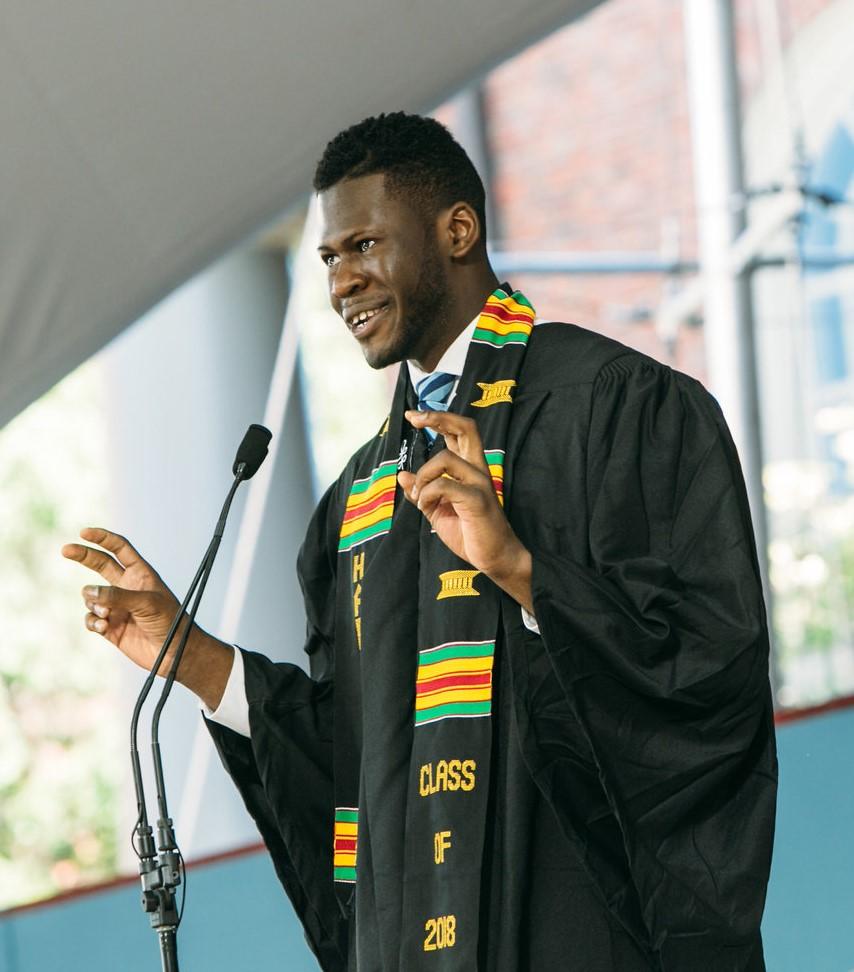

Hearing the Latin in today’s ceremony reminds us that not only the public Parts but the conferring of degrees was until 1896 conducted in that language. Harvard still uses the abbreviations for degrees in the Latin order rather than in the English, for example: A.B., Artium Baccalaureus; A.M., Artium Magister; and Ph.D., Philosophiae Doctor.
Conferring of Degrees
The Provost calls on the deans of the faculties, who present their candidates for degrees to the president and governing boards, beginning with the advanced degrees of the Faculty of Arts and Sciences. The graduate schools are presented in the order of their date of institution. Each dean addresses the governing boards with the following salutation: “Mr. President, Fellows of Harvard College, Mr. or Madam President” (here referring to the current president of the Board of Overseers) “and Members of the Board of Overseers,” before presenting the candidates, who stand in place while the president confers their degrees. The president confers the degrees of Bachelor of Arts and Bachelor of Science last, in recognition of the central role of undergraduate education in the University. For this conferral the Class Committee, as representatives of their class, and the candidates for degrees summa cum laude, are summoned to “draw near” the platform to be greeted by the president, and the class is admitted to “the fellowship of educated individuals.”
Although the formal conferring of degrees is validated by the president’s pronouncement, the College did not until 1814 give actual diplomas. Before that, following the model of the English university, it was considered sufficient that the degrees were recorded when conferred, and for centuries the candidates were greeted by the president and given a symbolic book which they later had to return. Since most students wanted some- thing tangible as evidence of their intellectual accomplishments, beginning in 1645 and continuing until 1814, they were permitted to prepare their own diplomas for signature by the president and fellows. For this they paid a fee.
English university, it was considered sufficient that the degrees were recorded when conferred, and for centuries the candidates were greeted by the president and given a symbolic book which they later had to return. Since most students wanted some- thing tangible as evidence of their intellectual accomplishments, beginning in 1645 and continuing until 1814, they were permitted to prepare their own diplomas for signature by the president and fellows. For this they paid a fee.
Another practice the founders brought from England was that of insisting that candidates for the degree of Master of Arts would first have received the Bachelor of Arts. At Harvard, the first class to receive the Bachelor of Arts was the Class of 1642, and since most Bachelors of Arts at that time hoped to become ministers or teachers, they went on to study for the Master’s degree. Residence was not mandatory, but the lapse of three years, the payment of a fee, and proof of independent study were required. Eventually the last became purely nominal, and it was lightly observed that the only thing necessary for a Master’s degree was “five dollars, and three years out of jail.” After 1872, the awarding of the Master of Arts in this perfunctory fashion, called “in course,” came to an end.
The Master of Arts, up until 1830, could also be awarded ad eundem gradum — to the same degree — to those who had received a Master’s degree or its equivalent at a recognized university other than Harvard. A parallel practice since 1942 is that of bestowing an honorary Master’s degree on professors who hold no Harvard degree but who are appointed to tenured positions in any Harvard faculty. This degree, usually awarded at the first faculty meeting each year, admits the recipient to the Harvard family.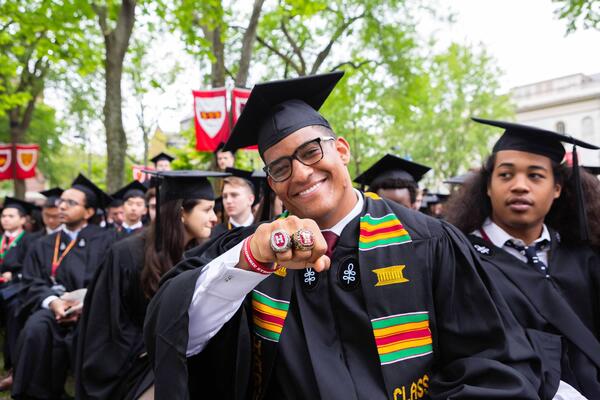 In the seventeenth and eighteenth centuries, candidates for degrees expected to be tested academically at Commencement itself, or to perform a ‘public act.’ Bachelor of Arts candidates prepared theses or topics on which they could be queried, and candidates for the Master of Arts submitted questions they were ready to defend. Titles of theses and questions were printed in advance to be handed out at Commencement, and visitors often took the opportunity of challenging the candidates on their knowledge. Today the term ‘thesis’ applies to the written results of research submitted by candidates for the Bachelor of Arts degree with honors in a field, or by candidates for doctoral degrees. Theses are examined and approved by appropriate members of the faculties.
In the seventeenth and eighteenth centuries, candidates for degrees expected to be tested academically at Commencement itself, or to perform a ‘public act.’ Bachelor of Arts candidates prepared theses or topics on which they could be queried, and candidates for the Master of Arts submitted questions they were ready to defend. Titles of theses and questions were printed in advance to be handed out at Commencement, and visitors often took the opportunity of challenging the candidates on their knowledge. Today the term ‘thesis’ applies to the written results of research submitted by candidates for the Bachelor of Arts degree with honors in a field, or by candidates for doctoral degrees. Theses are examined and approved by appropriate members of the faculties.
Conferring of Honorary Degrees
When the president completes the conferring of earned degrees he confers the honorary degrees and gives the diplomas, with an appropriate citation for each honorand. The tradition of bestowing honorary degrees began in European universities in the Middle Ages. In the seventeenth and eighteenth centuries there were few special awards at Harvard other than those of the Master of Arts ad eundem gradum mentioned earlier, and it is questioned whether they were honorary or earned. The first true honorary award is generally considered to be the Master of Arts conferred in 1753 on Benjamin Franklin. Twenty-three years later, in April 1776, the governing boards of Harvard awarded an honorary Doctor of Laws to General George Washington in grateful appreciation for his role in forcing the British evacuation of Boston.
Today the governing boards grant as honorary degrees the Master of Arts (A.M.) and Doctor of Laws (LL.D.), the Doctor of Science (S.D.), Doctor of Humane Letters (L.H.D.), Doctor of Literature (Litt.D.), Doctor of Music (Mus.D.), Doctor of Divinity (D.D.), and Doctor of Arts (Art.D.). Occasionally someone to whom an honorary degree is offered declines to accept. Grover Cleveland, twice president of the United States, is said to have refused an honorary Doctor of Laws at Harvard’s two hundred-fiftieth anniversary in 1886, because he felt that he was not learned enough in law to deserve the degree.
Literature (Litt.D.), Doctor of Music (Mus.D.), Doctor of Divinity (D.D.), and Doctor of Arts (Art.D.). Occasionally someone to whom an honorary degree is offered declines to accept. Grover Cleveland, twice president of the United States, is said to have refused an honorary Doctor of Laws at Harvard’s two hundred-fiftieth anniversary in 1886, because he felt that he was not learned enough in law to deserve the degree.
Sixteen presidents of the United States have received honorary degrees from Harvard, some before they became president. They include George Washington, John Adams, Thomas Jefferson, James Monroe, John Quincy Adams, Andrew Jackson, Ulysses S. Grant, Rutherford B. Hayes, Theodore Roosevelt, Howard Taft, Woodrow Wilson, Herbert Hoover, Franklin D. Roosevelt, Dwight D. Eisenhower, John F. Kennedy, and George Herbert Walker Bush.
In 1955, Helen Keller was the first woman to be awarded an honorary degree, that of Doctor of Laws. Since then many women have been so honored.
The University makes an effort to keep the names of the honorands confidential until the actual Commencement ceremony, in the event that a specific candidate is unable to attend. Since 1900, honorary degrees have been given only if the candidate appears in person: rarely has an honorary degree been voted but not conferred, as in the 1945 Master of Arts degree awarded to World War II war correspondent Ernie Pyle, who was killed in action before Commencement. Others include the 1946 degrees for Generals George Marshall and Douglas MacArthur, who could not be present. General Marshall came to receive his degree the following year, and in 1947 delivered the memorable speech in which he announced proposals that became the Marshall Plan for the reconstruction of post-war Europe.
Commencement as ‘Festival Rites’
In colonial times the ceremony, ending in the late afternoon, was followed by a Commencement dinner with speeches, singing, the consumption of wine and “plumb-cakes,” and much revelry. Graduate students returning to receive the Master of Arts degree rejoined old classmates, and the evening was a time for festive class reunions. Before long Harvard’s Commencement became a holiday in all of Cambridge, attracting not only alumni and parents, but everyone in the general population who had soon realized that Commencement pro- vided a good party. Booths featuring food, drink, and the performance of short impromptu plays were set up on Cambridge Common, and it was a highly riotous time since life in New England in those days offered little in the way of public entertainment or fun. College and civic authorities, including a constable with six men, were hard-pressed to keep the festivities under control. To this day both the sheriff of Middlesex County and the sheriff of Suffolk County attend Commencement, the former opening and closing the ceremony as a pleas- ant reminder that he, as was the Marshal-General of the Colony before him, is invited to preserve order.
At the Harvard bicentennial in 1836, a formal alumni organization was proposed which in 1840 held its first meeting; by 1869, the traditional post- Commencement dinner celebration had combined with that of the Alumni Association and moved to the middle of the day. From 1905, a luncheon organized in the name of the Chief Marshal of the Alumni for Commencement, elected by the College’s Twenty-fifth reunion class, was held directly after the Morning Exercises to entertain the governing boards, honorary degree recipients, and distinguished guests, while other class luncheon ‘spreads’ were located throughout the Yard. In 2022, the Senior Fellows’ spread will be held for the honored guests, while the Chief Marshal’s luncheon, along with those of other alumni/ae, will be moved with Harvard College reunions to the week following Commencement. In accordance with a tradition begun in 1950, the newly-minted Harvard graduates return to their separate Houses or graduate schools for luncheons with their families and guests, where they receive their individual diplomas in smaller, more intimate ceremonies.
Music
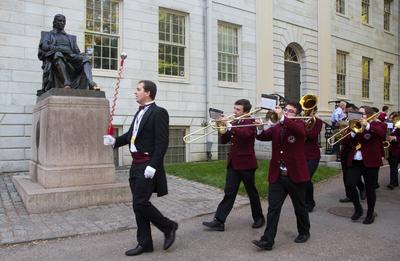 The music of voice and instrument weaves through the fabric of every Harvard Commencement from the beginning of the ceremony to the end, with stirring music played by the Harvard University Band accompanying the academic procession into the Tercentenary Theatre. The Commencement Choir, composed of students from the Harvard Glee Club, the Radcliffe Choral Society, the Harvard-Radcliffe Collegium Musicum, and members of the Harvard University Choir, offers four anthems during the program. One of them, a part of Harvard Commencement since its inception, is a metrical version of Psalm 78 – St. Martin’s – set to music by the eighteenth-century psalm-tune composer, William Tans’ur. Another, Fair Harvard, was composed in 1836 by the Reverend Samuel Gilman, Class of 1811, for the College’s two hundredth anniversary, and set to the traditional Irish air, Believe Me, If All Those Endearing Young Charms, which was written and published in 1808 by the poet Thomas Moore. The lyrics of Gilman’s Fair Harvard have twice been revised, once in 1998 and again in 2017, and this beloved Harvard anthem is sung by the entire assembly after the awarding of the honorary degrees and the Commencement Speaker’s address.
The music of voice and instrument weaves through the fabric of every Harvard Commencement from the beginning of the ceremony to the end, with stirring music played by the Harvard University Band accompanying the academic procession into the Tercentenary Theatre. The Commencement Choir, composed of students from the Harvard Glee Club, the Radcliffe Choral Society, the Harvard-Radcliffe Collegium Musicum, and members of the Harvard University Choir, offers four anthems during the program. One of them, a part of Harvard Commencement since its inception, is a metrical version of Psalm 78 – St. Martin’s – set to music by the eighteenth-century psalm-tune composer, William Tans’ur. Another, Fair Harvard, was composed in 1836 by the Reverend Samuel Gilman, Class of 1811, for the College’s two hundredth anniversary, and set to the traditional Irish air, Believe Me, If All Those Endearing Young Charms, which was written and published in 1808 by the poet Thomas Moore. The lyrics of Gilman’s Fair Harvard have twice been revised, once in 1998 and again in 2017, and this beloved Harvard anthem is sung by the entire assembly after the awarding of the honorary degrees and the Commencement Speaker’s address.
The Happy Committee
The Happy Observance of the Commencement Committee is known affectionately as the “Happy Committee.” This group of committed alumni volunteers was first charged with oversight of the Afternoon Program in 1869. They are recognized by their unmistakable regalia: top hats and tails for men, all black outfits adorned with crimson rosettes for women; and the noteworthy batons that came into use in the 1980s. Today, a group of more than 80 committee members — assisted by hundreds of alumni marshals and aids — escort students, family members, guests, dignitaries, and alumni in and out of Tercentenary Theatre; and marshal the annual alumni procession that is featured at the Annual Meeting of the Harvard Alumni Association. For more insight into the Happy Committee, read "Make Someone Happy."
Meeting Adjourned
The Commencement Exercises conclude when the Pusey Minister pronounces the benediction. On a signal given by the University Marshal, the Sheriff of Middlesex County once again stamps his staff three times and, raising his voice to be heard above the crowd, declares, “The meeting is adjourned!” The President’s Division then leaves the platform to depart by the center aisle toward Widener Library. When the entire official party has left the stage the Memorial Church bell rings, the bells of Cambridge peal, and the University Band heralds the end of the ceremony. Striking a spirited march, it keeps step with the throng of alumni/ae, students and faculty, families and friends moving through Tercentenary Theatre and the Old Yard “from,” as The Reverend Samuel Gilman, Class of 1811, wrote in Fair Harvard, “the Age that is past, to the Age that is waiting before.”
Additional information:
The Spirit & Spectacle of Harvard Commencement by Marvin Hightower
From the Archives: The Ultimate Commencement Address by John T. Bethell
Reading the Regalia: A guide to deciphering the academic dress code by Cynthia W. Rossano
Crow’s Feet and Crimson: Academic Dress at Harvard by Nicholas A. Hoffmann
Academic Costumes Defined (1902) by the Harvard University Council







